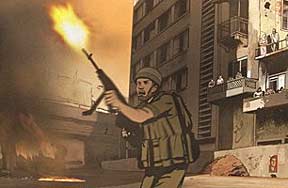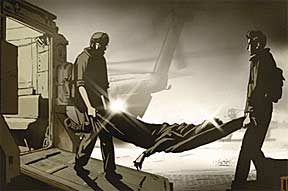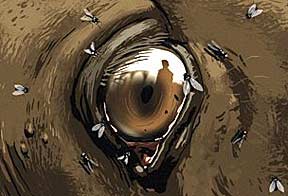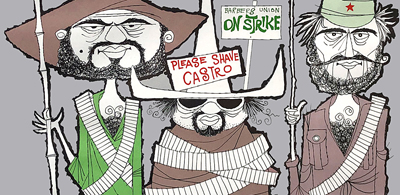Waltz with Bashir
It took Israeli director Ari Folman four years to create Waltz with Bashir, an unusual autobiographical animated film now in limited engagement across the U.S. that warns of the nightmares that follow in the wake of war. The movie opens with an unsettling vision, a pack of rabid dogs – twenty six to be exact, racing along wet streets under yellowy skies, frothing at the mouth and evidently looking for something to kill. Lushly animated in clashing hues of cobalt and ochre, the apparition is a dream suffered by Boaz Rein Buskila, an Israeli army veteran of the 1982 invasion of Lebanon.

In the follow-up scene Boaz tells his close friend Ari Folman about the ominous dream and its meaning, it was actually a memory of sorts. During the war on Lebanon, as part of an Israeli infantry unit sent under cover of darkness into Palestinian villages to snatch suspects, Boaz was required to shoot the village dogs with a silenced sniper rifle to prevent their barking and waking the town’s occupants. He remembered each dog – all twenty six of them, their size and shape, how they whimpered when shot, how they died. Now the slaughtered dogs were back, and they were pursuing Boaz in his sleep. He asked his friend Ari if he also had nightmares about his service in Lebanon, but Folman could not remember anything at all about the war, he had no dreams or recollections – he was absolutely blank. Folman’s quest for his lost memories began at that moment, and the rest of the film recounts his struggle to dredge up that life history.
Based on Folman’s real life experiences as a soldier in the Israeli army when it invaded Lebanon in June ‘82, Waltz with Bashir is only the second animated feature film to be produced in Israeli cinematic history – the first was made in 1961. Folman did not use rotoscope techniques in producing his film, rather the animation, directed by Yoni Goodman, was achieved through a combination of Flash and 3-D software with classic hand drawn animation. The feature had a budget of $1.7 million and its entire animation crew was composed of ten individuals.
By contrast, Pixar’s Finding Nemo had a budget of $150 million and a technical crew of over forty animators. Most people have good reason to regard animation as nothing more than kid stuff, but Folman has given us a profoundly serious and complicated film for thinking adults. Waltz with Bashir is not lacking in any respect, in fact it is a devastatingly effective look at the folly and hubris of war. Watching the movie’s online trailer gives evidence of just how powerful Folman’s animated feature is. At a press conference that took place at the 2008 Cannes Film Festival where the film premiered, Folman said;
“The basic statement of the film and the understanding of the film is prosaic: wars are useless, completely useless, any war. There are a lot of anti-war movies, but in the eyes of a teenager, the anti-war films miss their goal completely, sometimes you just don’t get it right. Because it is animated, I hope that a sixteen year old boy watching ‘Waltz With Bashir‘ in Israel will say, ‘I don’t want to take any part in this war again.'”
A strangely beautiful sequence from the film gave the movie its name; an Israeli soldier is shown “waltzing” with his machine gun while under fire on a bomb blasted Beirut boulevard – that is to say, he was wildly firing at everything in sight. The scene takes place against a backdrop of street posters extolling Bashir Gemayel – the leader of the Lebanese right-wing Christian Phalangist party. But the film’s title is more than just a metaphor for the insanity and brutality of war. Gemayel was politically aligned with Israel and fanatical about expelling the Palestinians from Lebanon. When Gemayel was assassinated by unknown assailants, Phalangist militia men attacked the Palestinian refugee camps of Sabra and Shatila, slaughtering thousands of innocent civilians while the Israeli army looked on. As a 19-year-old soldier, Folman was stationed on the outskirts of Sabra, firing flairs to illuminate the camp at night. He became so racked with guilt over his actions that he blocked his entire wartime experience from memory.

In the finale of Waltz With Bashir, all of Folman’s wartime memories come flooding back to him, as the animation dissolves into truly shocking live-action archival footage showing the aftermath of the killing spree at Sabra and Shatila. The ending is a hammer blow of pure journalistic force. Reuters quoted the director at the 2008 Cannes Film Festival, commenting on the final scene;
“I didn’t want you as the audience to go out of the theater after watching ‘Waltz With Bashir‘ and think, yes, this is a cool animation film’. These things happened … thousands of people were killed, kids were killed, women were killed, old people were killed. In order to put the whole film into proportion, those 50 seconds were essential to me.”
Israel’s 1982 invasion of Lebanon, dubbed “Operation Peace for the Galilee”, was launched by Israeli prime minister Menachem Begin. Ostensibly meant to destroy the PLO, the operation killed untold thousands of Lebanese and Palestinian civilians, took the lives of hundreds of Israeli soldiers, and left Lebanon in ruins. Ultimately the war culminated in the unspeakable massacre of thousands of innocent Palestinian civilians at the Sabra and Shatila refugee camps. The war’s initial onslaught was followed by an 18-year-long military occupation, but Israel’s military superiority brought it no closer to peace and security; as evidenced by the current fighting in the Gaza strip – the most densely populated area on earth and arguably the largest prison camp in the world.

Waltz with Bashir is filled with disturbing imagery that is both surrealistic and hallucinogenic. One of my favorite moments in the film is of Folman remembering being on leave from the Lebanese front. That particular scene involves the young soldier back home in Israel, feeling displaced and uncomfortable that everyone was “living normally”, as if a war was not being fought. Folman listlessly shuffles on a bustling street as crowds blur by him, he becomes immobilized in front of a shop window displaying television sets – all of which are showing a speech by prime minister Begin. The channel is abruptly switched and the TV sets are suddenly broadcasting a performance by John Lydon’s post-Sex Pistols band, Public Image Ltd (Pil) – the grating din being the group’s anti-melody, This Is Not A Love Song.
The unexpected appearance of Pil on that bank of televisions rang true for me (even though the Pil song was released a year after the ‘82 war), and that scene set off an avalanche of personal memories. Widely interpreted as scathing mockery aimed against the music industry’s endless production of saccharine romance tunes, This Is Not A Love Song took on a whole new meaning in Waltz with Bashir. The composition became a poison letter delivered to our modern consumer society – especially as the piece of music worked its way through the war addled mind of a young soldier suffering from post-traumatic stress disorder.
In November of 1982 Israeli prime minister Menachem Begin was invited to speak at the Bonaventure Hotel in downtown Los Angeles, and in response the “Committee to Oppose the Begin Visit” called for a peaceful demonstration to protest the invasion of Lebanon. At the time a handful of friends and I were active participants in L.A.’s punk rock movement, and we decided to attend the rally to express our outrage over the mass murder at Sabra and Shatila. Thousands showed up at the demonstration, and somehow two of my punk friends and I sailed through the lines of the LAPD riot squad and cordons of Secret Service agents to actually enter the Bonaventure – which was no small feat considering we were the ugliest gang of social deviants you could ever imagine.
Sporting spiky colored hair, ripped and torn bondage clothes covered with hand painted slogans, combat boots, leather jackets, peace buttons, and Arab kaffiya scarves; we miraculously made our way to the top floor of the hotel totally unimpeded by security and stood outside of the main ballroom for a few moments to greet delegates with sneers and generally rude buffoonery. I recall delegates reacting to us as if we were lepers. We soon tired of our antics and left the premises to rejoin the antiwar rabble in the streets, astonished that we had not been arrested. Hundreds of high-powered supporters of Israel were in that ballroom, including the Governor of the State of California, Jerry Brown, and L.A.’s Mayor, Tom Bradley. As fate would have it Begin’s scheduled speech was cancelled due to the death of his wife, but Israel’s ambassador to the U.S., Moshe Arens, filled in for the grieving prime minister.
The bloodbath at Sabra and Shatila shocked the international community, and my response to the cataclysm was to create a silkscreen print in 1983 that memorialized the massacres. Based upon a pencil drawing I made in the weeks immediately following the atrocities, my artwork paid homage to the innocents who lost their lives in those wretched camps. I have long felt that my artistic gesture was misconstrued by some, but after viewing Ari Folman’s astonishing film, I feel vindicated and in good company.
In the end an Israeli government commission found the Israeli Defense Forces “indirectly responsible” for the mass executions. Israel’s Defense Minister, Ariel Sharon, was found to bear “personal responsibility” for “not taking appropriate measures to prevent bloodshed.” Sharon resigned his Defense Minister position but later became the Prime Minister of Israel in 2001.

A human tragedy of momentous proportions is again unfolding, this time in the Israel-blockaded Gaza strip. It is a catastrophe that may develop into a wider war if not a regional conflagration. At the time of this writing at least 435 Palestinians have been killed and an estimated 2,000 injured in the massive Israeli bombings of Gaza. Three Israeli civilians and one soldier have been killed by rockets launched into Israel by Hamas militants. The Israeli army launched a ground invasion into Gaza late January 3, using tanks and infantry, a move that will undoubtedly cause civilian casualties to skyrocket.
Without a doubt, George W. Bush has given the Israelis a green light for military action, but supporters of President Barack Obama still expect him, as the candidate of “Hope and Change”, to break his silence and make a statement against the Israeli mauling of the Palestinians. Despite his vociferous rhetoric about “winning in Afghanistan” and enthusiastically lobbying for a $700 billion bailout for Wall Street, Mr. Obama claims there “can only be one president at a time” as a justification for his remaining mute. As we enter the second week of Israel’s bombardment of Gaza, Obama remains silent on the matter – evidently he has decided to Waltz with Bashir.
[ As a side note: On Saturday, Jan. 10, 2009, at 1:00 pm, the Egyptian Theatre in Hollywood will present a free public discussion with Ari Folman as well as the directors of the four other foreign language films nominated for this year’s Golden Globes. Running up to this, from January 7-10, the films up for nomination will screen at the Aero Theatre in Santa Monica. Waltz With Bashir is also currently screening at L.A.’s Laemmle Theatres. ]



